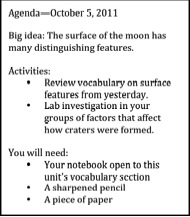(Dis)organized students
By Mary Bigelow
Posted on 2011-10-05
My middle school students this year are very scatterbrained. It seems to take forever for them to get focused at the beginning of class and to find the materials they need when I ask for them during class. When it’s time to get into groups for a lab activity, there is a lot of commotion. Then they have lots of questions about what they’re supposed to be doing. Last year’s classes weren’t like this at all. What can I do?
—Margaret, North Carolina
It’s a common topic in the faculty room: “My classes last year were _____. This year they are so _____.” Teachers fill in the blanks with words such as cooperative, talkative, immature, energetic, needy, noisy, or inquisitive. It sounds like you would use disorganized to describe this year’s students.
For these students, you may need to establish routines to help them get and stay organized. Established routines free up time for more important topics and activities than dealing with logistical issues.
Visualize what a class activity should “look like.” In your mind, go through the activity in slow motion and focus on what the students should do to accomplish the task in an orderly and timely fashion. For example, you might establish routines for students to get their notebooks, access lab equipment, or enter/leave the room. Here are some routines that worked for me.
The beginning of a class period can be hectic as one group leaves, another enters, and the teacher takes attendance and performs other duties. Try posting an “agenda” that students see as they come in. Set aside a section of the board or project the agenda onto the interactive board. The agenda could include the purpose or big idea of the lesson, the activities for the class period, assignments they should have ready for you to check or turn in, and what they need to have ready at their seats (laptop, notebook, paper, pencil, textbook, etc.).
It may take a few days for students to get used to the routine of reading the agenda and getting things ready at their seats. I found that combining the agenda with a brief warm-up activity helped students focus for the rest of the period.
Rather than students selecting different teammates for each activity, use the same lab groups for a while. Assign students to groups, with a promise that you’ll change them in the future. Designate a space for each team to work on lab activities. Appoint one student in each group as the “coordinator” whose job is to get the materials for the activity. He or she should be the only one from the group who needs to move around the room. But you can minimize that movement by having all of the materials for each group in a box or tray. Designate another student in each group to be the “liaison.” This student is the group’s spokesperson and is allowed to ask you questions about the activity on the group’s behalf.
Routines at the end of the class period can help students organize their thinking before going on to the next class. For example, ask the students to complete a brief exit activity before departing. This can be a written summary in their notebooks about the day’s activities, thoughts about an upcoming lesson, or a reminder of due dates for tests, projects, or other assignments.
When students are learning your routines, you’ll need to demonstrate and model them and provide opportunities for practice. Since the school year has already started, it may take a while for students to catch on to them, but the effort is worth it.
Disclaimer: The views expressed in this blog post are those of the author(s) and do not necessarily reflect the official position of the National Science Teaching Association (NSTA).

